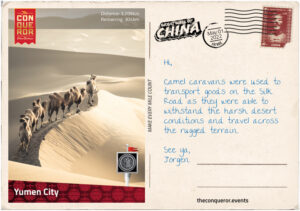När det endast återstår 304 km, alltså 3 209 km avverkade, kom det tjugosjunde vykortet.

Tjugosjunde vykortet
Located west of the Hexi Corridor on the edge of Gobi Desert is the small city of Yumen. Today it is an industrial city, primarily focused on oil drilling, wind power-generation and large-scale factories. However, 2,100 years ago, when it came under Han Dynasty control, it was a thoroughfare for merchants, warriors, diplomats and missionaries to trade goods and exchange knowledge, technology and religious beliefs.
Read More